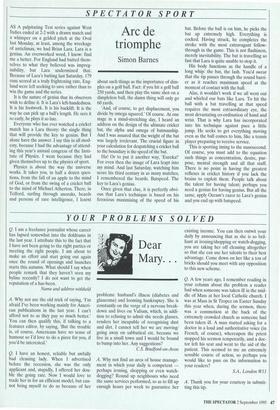SPECTATOR SPORT
Arc de triomphe
Simon Barnes
AS A palpitating Test series against West Indies ended at 2-2 with a drawn match and a whimper on a gelded pitch at the Oval last Monday, at least, among the wreckage of anticlimax, we had Brian Lara. Lara is a genius. An overworked word, I know: find me a better. For England had batted them- selves to what they believed was impreg- nability, but Lara undermined that. Because of Lara's batting last Saturday, 179 runs scored at a truly frightening rate, Eng- land were left seeking to save rather than to win the game and the series.
It is the nature of genius that its observers wish to define it. It is Lara's left-handedness. It is his footwork. It is his backlift. It is the way he can pick up a ball's length. He sees it so early, he plays it so late.
Everyone who has ever watched a cricket match has a Lara theory: the single thing that will provide the key to genius. But I alone have the answer. I say this in all mod- esty, because I had the advantage of attend- ing this year's annual congress of the Insti- tute of Physics. I went because they had given themselves up to the physics of sport.
Physics is about the way the universe works. It takes you, in half a dozen ques- tions, from the fall of an apple to the mind of God, or from the swing of a cricket ball to the mind of Michael Atherton. There, in Telford, surfing through anoraks, beards and persons of rare intelligence, I learnt about such things as the importance of dim- ples on a golf ball. Fact: if you hit a golf ball 250 yards, and then play the same shot on a dimpleless ball, the damn thing will only go 60 yards.
'And, of course, to get displacement, you divide by omega squared.' Of course. At one stage in a mind-stretching day, I heard an address on the design of the ultimate cricket bat, the alpha and omega of batmanship. And I was assured that the weight of the bat was largely irrelevant. The crucial figure in your calculation for despatching a cricket ball to the boundary is the speed of the bat.
Ha! Or to put it another way, 'Eureka!' For even then the image of Lara leapt into my mind. And last Saturday, watching him score his third century in as many matches, I remembered the beards. Batspeed. The key to Lara's genius.
Once given that clue, it is perfectly obvi- ous that Lara's technique is based on his ferocious maximising of the speed of his bat. Before the ball is on him, he picks the bat up extremely high. Everything is cocked. Having struck, he completes the stroke with the most extravagant follow- through in the game. This is not flashiness, merely inevitability. The bat is travelling so fast that Lara is quite unable to stop it.
His body functions as the handle of a long whip: the bat, the lash. You'd swear that the tip passes through the sound barri- er as it reaches maximum speed at the moment of contact with the ball.
Alas, it wouldn't work if we all went out and whirled our bats like Lara. To hit the ball with a bat travelling at that speed requires the most extraordinary eye, the most devastating co-ordination of hand and wrist. That is why Lara has incorporated into his technique against pace a little jump. He seeks to get everything moving even as the ball comes to him, like a tennis player preparing to receive service.
This is sporting iming to the nanosecond. Of course, you must add to the equation such things as concentration, desire, pur- pose, mental strength and all that stuff. There is no point in having the greatest reflexes in cricket history if you lack the brains to exploit them. People talk about the talent for having talent; perhaps you need a genius for having genius. But all the same, apply Occam's razor to Lara's genius and you end up with batspeed.


















































 Previous page
Previous page